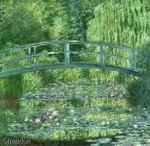As the colourful and original french artist Hernri Matisse said once, “Impressionism is the newspaper of the soul”. Some kind of soul may have this art style because today, Impressionist paintings are some of the best-known and best-loved in all art the collections.
According to Margaret Samu, Postdoctoral Fellow at The Metropolitan Museum of Art, “in 1874, a group of artists called the Anonymous Society of Painters, Sculptors, Printmakers, etc. organized an exhibition in Paris that launched the movement called Impressionism. Its founding members included Claude Monet, Edgar Degas, and Camille Pissarro, among others.” That is how the term “Impressionism” was first used.
The Impressionisim was characterized because the early Impressionist artists breaking the academis painting rules. It started as a free, new, modern style. Soon, the style started to gain some specific techniques. According to Wikipedia these are some of the Impressionist Techniques:
- Short, thick strokes of paint are used to quickly capture the essence of the subject, rather than its details. The paint is often applied impasto.
- Colours are applied side-by-side with as little mixing as possible, creating a vibrant surface. The optical mixing of colours occurs in the eye of the viewer.
- Grays and dark tones are produced by mixing complementary colours. In pure Impressionism the use of black paint is avoided.
- Wet paint is placed into wet paint without waiting for successive applications to dry, producing softer edges and an intermingling of colour.
- Painting in the evening to get effets de soir – the shadowy effects of the light in the evening or twilight.
- The play of natural light is emphasized. Close attention is paid to the reflection of colours from object to object.
- In paintings made en plein air (outdoors), shadows are boldly painted with the blue of the sky as it is reflected onto surfaces, giving a sense of freshness and openness that was not captured in painting previously. (Blue shadows on snow inspired the technique.)
 Even if some rules or techines were followed also in this style, “its many facets and varied participants make the Impressionist movement difficult to define. Indeed, its life seems as fleeting as the light effects it sought to capture. Even so, Impressionism was a movement of enduring consequence, as its embrace of modernity made it the springboard for later avant-garde art in Europe.” claims Samu.
Even if some rules or techines were followed also in this style, “its many facets and varied participants make the Impressionist movement difficult to define. Indeed, its life seems as fleeting as the light effects it sought to capture. Even so, Impressionism was a movement of enduring consequence, as its embrace of modernity made it the springboard for later avant-garde art in Europe.” claims Samu.
References:
- Impressionism. (2010, December 15). In Wikipedia, The Free Encyclopedia. Retrieved 10:14, December 21, 2010, from http://en.wikipedia.org/w/index.php?title=Impressionism&oldid=402562851
-
Samu, Margaret. “Impressionism: Art and Modernity”. (2004, October). In Heilbrunn Timeline of Art History. New York: The Metropolitan Museum of Art, 2000–. Retrieved 10:20, December 21, 2010, from http://www.metmuseum.org/toah/hd/imml/hd_imml.htm
-
Henri Matisse. In El poder de la palabra. Retrieved 10:23, December 21, 2010, from http://www.epdlp.com/pintor.php?id=307
-
Henri Matisse. In The Painter´s Key. Retrieved 10:27, December 21, 2010, from http://quote.robertgenn.com/getquotes.php?catid=149
-
Guide to Impressionism. In The National Gallery. Retrieved 10:34, December 21, 2010, from http://www.nationalgallery.org.uk/paintings/learn-about-art/guide-to-impressionism/guide-to-impressionism
Filed under: Arts, Humanities
![]()